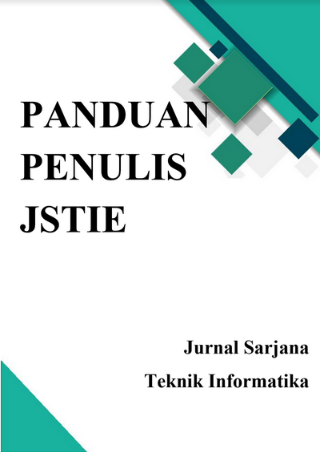SISTEM IDENTIFIKASI CITRA JENIS KUNYIT (Curcuma Domestica Val.) MENGGUNAKAN METODE KLASIFIKASI MINKOWSKI DISTANCE FAMILY
DOI:
https://doi.org/10.12928/jstie.v1i2.2264Abstract
Sistem pengenalan untuk identifikasi kunyit berbasis komputer merupakan proses memasukkan informasi berupa citra kunyit ke dalam komputer. Selanjutnya komputer menerjemahkan serta mengidentifikasi jenis kunyit tersebut dengan menggunakan metode klasifikasi Minkowski Distance Family. Proses klasifikasi dalam penelitian ini adalah membandingkan empat metode metrik jarak Euclidean, City Block, Chebyshev dan Minkowski menggunakan pengurangan rerata citra sampel dengan vektor citra testing dengan membandingkan nilai minimum dari metode metrik tersebut. Pengujian unjuk kerja sistem dilakukan dengan melakukan variasi ukuran citra 10x10, 10x15, dan 10x20. Pada penelitian ini telah dilakukan perancangan sistem identifikasi kunyit yang memanfaatkan kamera digital untuk akuisisi data citra kunyit. Selanjutnya dilakukan pemrosesan awal, ekstrasi ciri dan pengklasifikasi. Pada pengembangan sistem ini terdiri 2 tahap yaitu tahap penentuan pola standar referensi dan pengujian. Data yang digunakan sebagai standar referensi sebanyak 5 sampel untuk masing-masing jenis kunyit yaitu turina dan lokal. Sedangkan untuk pengujian untuk kerja sistem menggunakan 15 sampel untuk masing- masing jenis kunyit.
Kata Kunci: identifikasi kunyit, Minkowski Distance Family, metrik jarakReferences
Munir , Rinaldi. 2004. Pengolahan Citra Digital dengan Pendekatan Algoritmik. Informatika. Bandung.
Putra , Darma. 2010. Pengolahan Citra Digital. Andi. Yogyakarta..
Syukur, Cheppi. 2010. Turina, Varietas Unggul Kunyit Kurkumin Tinggi. Sinar Tani Edisi 3-9 November.
Murinto. 2010. Petunjuk Praktikum Pengolahan Citra. Universitas Ahmad Dahlan. Yogyakarta
Fadlil, A. (2008). Perancangan Program Pengenalan Wajah Menggunakan Fungsi Jarak Metode Euclidean Pada Matlab. Seminar Nasional Aplikasi Teknologi Informasi.
Fadlil, A. 2012. Sistem Pengenalan Citra Jenis-Jenis Tekstil, Spektrum Industri, vol 10, no 1, pp. 21-29.
Sung-Hyuk Cha.2007.Comprehensive Survey on Distance/Probability Density Function, Journal of Mathematical Models and Methods in Aplied Sciences, issue 4, volume 1, pp 300-307.
D. Randall Wilson and Tony R. Martinez, “Improved Heterogeneous Distance Functionsâ€, Journal of Artificial Intelligence Research, vol 6, 1997, pp. 1-34.
Downloads
Published
Issue
Section
License
License and Copyright Agreement
In submitting the manuscript to the journal, the authors certify that:
- They are authorized by their co-authors to enter into these arrangements.
- The work described has not been formally published before, except in the form of an abstract or as part of a published lecture, review, thesis, or overlay journal. Please also carefully read Journal Posting Your Article Policy.
- The work is not under consideration for publication elsewhere.
- The work has been approved by all the author(s) and by the responsible authorities – tacitly or explicitly – of the institutes where the work has been carried out.
- They secure the right to reproduce any material that has already been published or copyrighted elsewhere.
- They agree to the following license and copyright agreement.
Copyright
Authors who publish with Jurnal Sarjana Teknik Informatika agree to the following terms:
- Authors retain copyright and grant the journal right of first publication with the work simultaneously licensed under a Creative Commons Attribution License (CC BY-SA 4.0) that allows others to share the work with an acknowledgement of the work's authorship and initial publication in this journal.
- Authors are able to enter into separate, additional contractual arrangements for the non-exclusive distribution of the journal's published version of the work (e.g., post it to an institutional repository or publish it in a book), with an acknowledgement of its initial publication in this journal.
- Authors are permitted and encouraged to post their work online (e.g., in institutional repositories or on their website) prior to and during the submission process, as it can lead to productive exchanges, as well as earlier and greater citation of published work.







